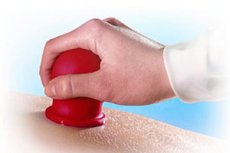Medical expert of the article
New publications
Mechanotherapy
Last reviewed: 04.07.2025

All iLive content is medically reviewed or fact checked to ensure as much factual accuracy as possible.
We have strict sourcing guidelines and only link to reputable media sites, academic research institutions and, whenever possible, medically peer reviewed studies. Note that the numbers in parentheses ([1], [2], etc.) are clickable links to these studies.
If you feel that any of our content is inaccurate, out-of-date, or otherwise questionable, please select it and press Ctrl + Enter.

Mechanical effects on the skin used in hardware cosmetology can be constant (usually called mechanical stress) and variable, caused by mechanical vibrations.
In turn, mechanical stresses can be divided into effects of pressure higher (pressotherapy) and lower (vacuum therapy) than atmospheric pressure.
Let us take a closer look at the most frequently encountered mechanotherapeutic procedures used in modern beauty and health centers.
Hardware massage and pressotherapy (syn.: pulse barotherapy) consist of periodic dosed mechanical action on the skin. In the case of pressotherapy, periodic pressure is applied to the tissue using cuffs with compressed air. Local changes in pressure on the tissue can be modulated, i.e. the direction of fluid filtration can be changed in one direction or another in accordance with the Starling equation. The period of alternating vacuum and compression during the pressotherapy procedure is from 30 sec to 2 min.
Pressotherapy, used in cosmetology, allows you to get rid of edema of various origins, fight cellulite and obesity, eliminate flabbiness of the skin, making it elastic and smooth. In addition, pressotherapy, having an antispasmodic and vasodilatory effect, is used in the complex treatment of persistent muscle tension, as well as for the prevention of varicose veins, relieving the feeling of heaviness and fatigue in the legs.
Vibrotherapy is a dosed effect of mechanical vibrations of low frequency (20–200 Hz) and amplitude on the patient’s entire body or on its individual parts. The effects of vibrotherapy are as follows: increased blood circulation, stimulation of metabolic processes, improvement of neurotrophic functions, analgesic, anti-inflammatory and hyposensitizing effects. Vibrotherapy is used in the treatment of diseases and injuries of the nervous system (neuritis, neuralgia, plexitis, radiculitis) and the musculoskeletal system (bruises, ligament ruptures, neurocirculatory dystonia).
Vibrovacuum therapy is a complex effect on the body of local vacuum decompression (rarefaction) and vibration in order to stimulate nerve and muscle fibers. One of the effects of such an effect is the activation of metabolism, including fat metabolism (which is useful in the treatment of cellulite), blood flow in the underlying tissues also increases and lymphatic drainage improves. A course of vibrovacuum therapy helps to increase metabolism in all layers of the skin, which affects its appearance: its elasticity and turgor increase, and the formation of wrinkles is prevented.
Endermotherapy is a combined effect of local vacuum decompression and roller massage: under the action of a vacuum, the skin is lifted and forms a fold, which is captured by rollers and kneaded by them. Thus, both negative (due to the vacuum decompression system) and positive (movable rollers) pressure are exerted on the skin and underlying tissues. Dosed endermotherapeutic action activates microcirculation and lymphatic drainage, which improves the trophism of skin tissue and metabolism in all layers of the skin (including lipolysis in the subcutaneous fat).
Vibration massage relaxation is a combined effect on the human body of low-frequency vibration and periodic roller action, promoting psycho-emotional and physical relaxation.


 [
[